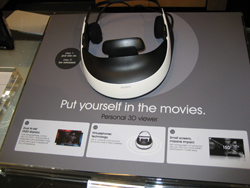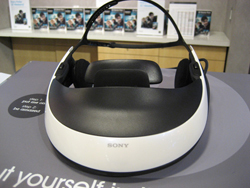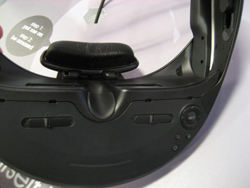Introduction to Impressions of Sony HMZ-T1
It seems like the dream of virtual reality peaked about 15 years ago and ever since I have had occasional nightmares where I wake up in a cold sweat, scared of a vision of the future without VR. The Lawnmower Man came out in 1992 and teased us with a virtual world where anything was possible. Then we saw VR gaming in stores like Incredible Universe. Sure the graphics were nothing spectacular, but the idea was there. I was a youngster back then, filled with hope and innocence. I was sure that by 2001 we would be walking around as Mario in a completely virtual world. That never happened and I could never figure out why. Perhaps building a lightweight, quality headset that didn’t give someone vertigo wasn’t feasible back then?
SONY HMZ-T1 SPECIFICATIONS
- Input: 1 HDMI 1.4a input
- Output: 1 HDMI 1.4a pass through-output
- Headphones: Open Air Dynamic 12-24,000Hz
- Display: 2 1280×720 OLED 24bit RGB
- Virtual Image Size: 150” at 12 feet
- Weight: 14.8oz
- Input: 1 HDMI 1.4a input
- Sony
- Sony – Personal 3D Viewer
- SECRETS Tags: sony, accessories, wireless
Well as we approach 2012, it seems that virtual reality is poised for resurgence. We’ve already see some great uses of augmented reality, placing computer generated objects into a live, interactive video source on systems like the PS3. The road to enhanced user interaction was paved by Nintendo’s Wii, only to be followed by the Sony Move and Microsoft Kinect. What if we could merry something like the Kinect with a heads up display? The Lawnmower Man suddenly doesn’t look so far-fetched anymore. In fact, there has already been some DIY projects that have added their own custom head tracking to Sony’s HMZ-T1 headset.
http://www.engadget.com/2011/11/19/sonys-hmz-t1-headset-gets-a-diy-vr-upgrade-video/ Could Sony’s HMZ-T1 take us to the next level of virtual reality? Or is it just another poorly designed gimmick. Well, I just had to find out for myself, so I scheduled some time with the HMZ-T1 at my local Sony Style.
Seeing the unit close up for the first time since a brief glance at CES (where the lines were too long), I thought it looked sleek and futuristic, like something from a 70’s sci-fi movie. The unit has quite a few adjustments for different head shapes, but I couldn’t quite get a comfortable fit. The weight, which is all upfront, rested directly on the bridge of my nose. I ended up leaning forward a bit, almost looking down, to let the headset “dangle” from my head. I’m sure with some tweaking a more comfortable position could be obtained, but I didn’t want to take up too much time adjusting.
The unit is comprised of 2 720p OLED panels, one for each eye. Any processing that needs to be done is handled by a separate box that has one HDMI input and one pass thru output. A long, thin cable runs from the box to the headset. On the bottom of the headset there are several buttons to control the HMZ-T1’s settings. There were some minor picture controls, but for the most part, what you see is what you get. Fortunately the quality from the OLED panels is quite nice.
I started out with some footage from the final Harry Potter. Now I’ve heard that the 3D was terrible on this Blu-ray, but honestly, I actually thought it looked pretty good through the HMZ-T1. I am not sure if it added anything to the experience, and I would still prefer a normal 2D presentation, but this was definitely watchable. Contrast looked very good, and the black levels were terrific. Next up was a Sony PS3 game, Motorstorm. Initially I was playing the game in 2D and thought it looked fantastic and I didn’t even realize the game wasn’t in 3D mode. After enabling the 3D, resolution was effectively cut in half due to the PS3 hardware not being able to render 2 full resolution screens at the same time. This did add quite a lot of aliasing and sparkle to object edges, but the added depth was fun. I wouldn’t choose 3D mode 100% of the time, but there are definitely games where it really pulls you into the action. Last up was Cars 2 on 3D Blu-ray. This really sold me on the technology. Colors looked fantastic, the 3D was natural, easy to focus on, and did not induce any eye strain. Having 2 distinct panels for each eye avoids having to use active shutter glasses, which give many people eye strain and headaches. If I could have, I would have watched the whole movie via the HMZ-T1.
Now the HMZ-T1 is a new product and it isn’t without flaws. First off, I immediately noticed a screendoor effect on the two OLED panels. I think if they used full 1080p resolution panels on future models that this would provide the user with a more seamless experience. Second was comfort. The front heavy HMZ-T1 was not as comfortable as wearing your favorite sunglasses. Further design refinements could make the unit more comfortable on the nose. Lastly would be the audio quality from the built in 5.1 headphones. Now I am pretty picky when it comes to personal audio and I am a bit spoiled with a pair of AKG 701’s so it is entirely possible that most people would be happy with the sound quality on the HMZ-T1. I felt it was a bit too muddy and lacked the punch you get with good home theater sound. If I had a unit for myself, I would sit in my dark home theater, pipe the sound through my speakers and enjoy a thoroughly immersive experience.
Sony’s new HMZ-T1 3D headset shows a lot of promise for this means of entertainment delivery. The 3D is the best I have seen, with no loss of resolution like passive LCD TV’s and no eye fatigue from active shutter glasses. I for one, hope it does well enough to prompt future, improved models that deliver flawless 3D picture quality. Go check them out!






